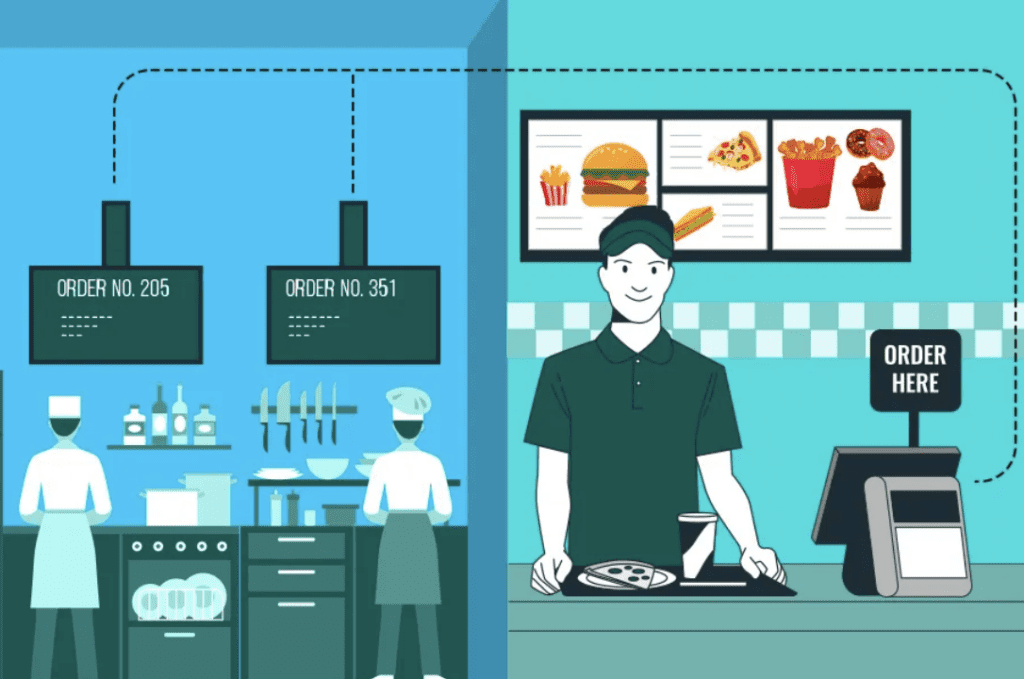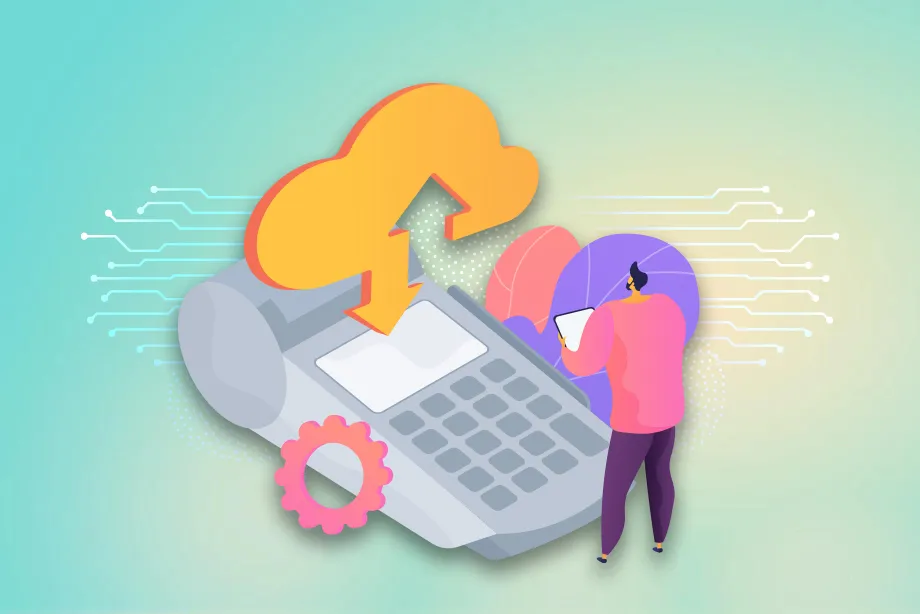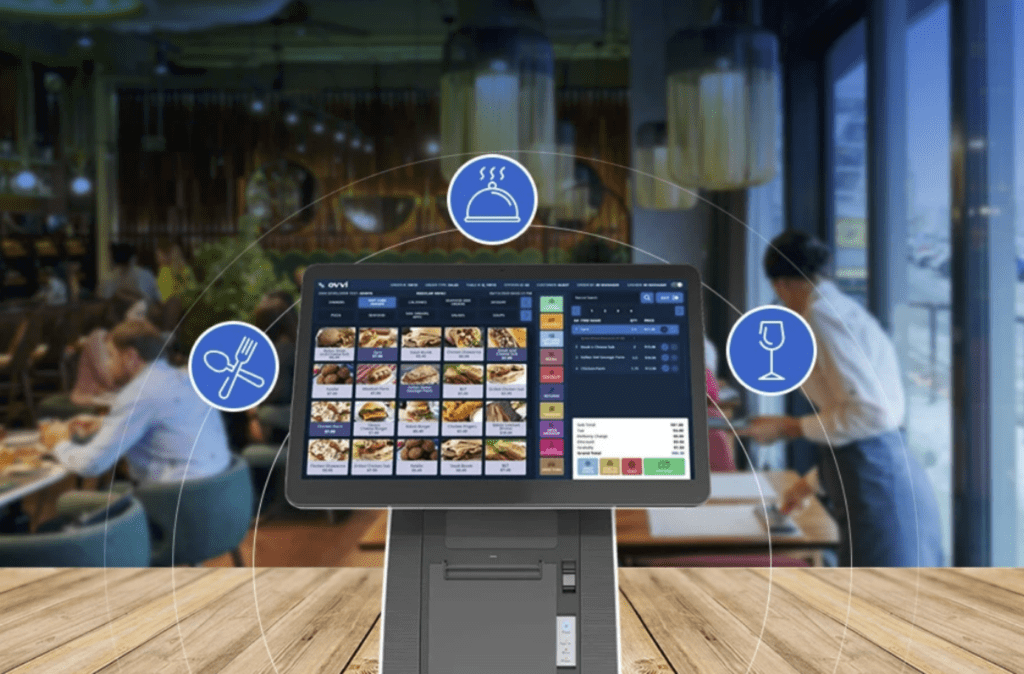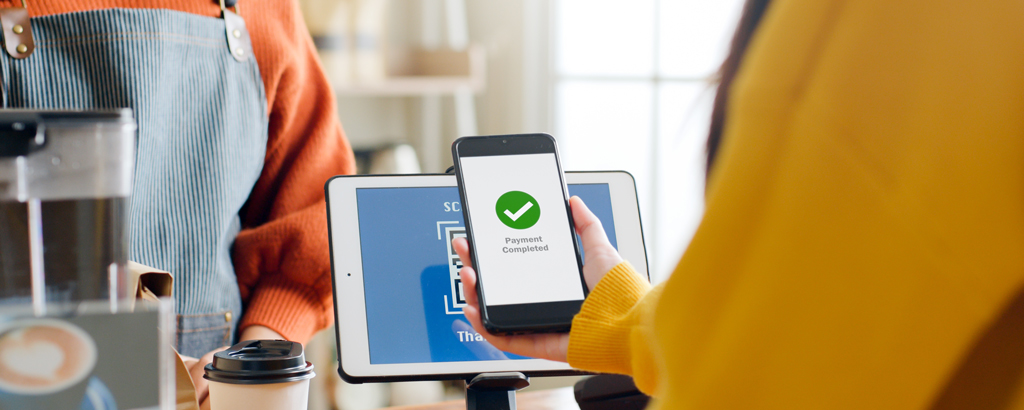
Making The Right decision: Tablet Versus Traditional POS
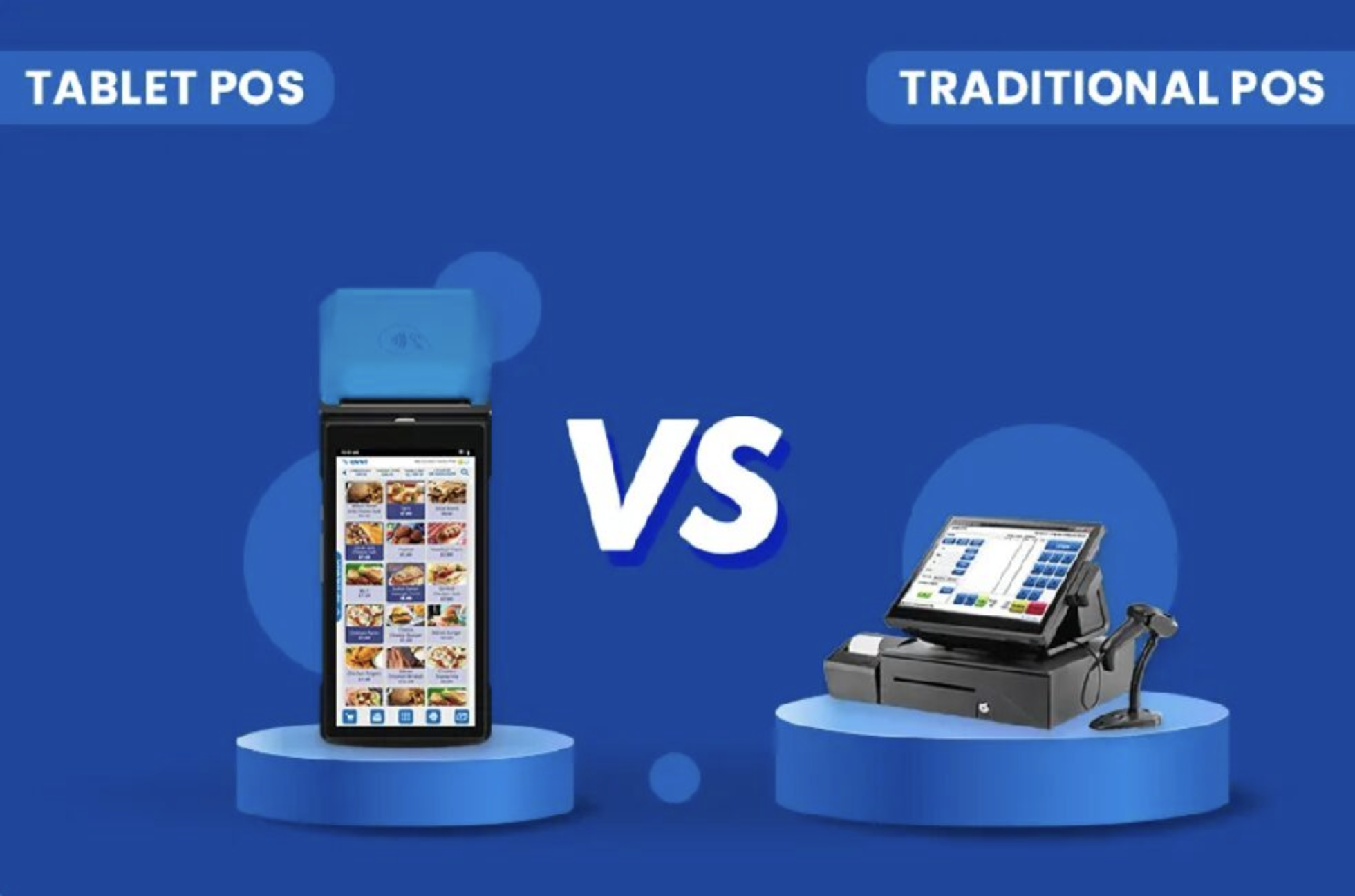
“Quick Summary” With their easy of use and transportability, tablets have gained extreme popularity. In the restaurant industry, many businesses perceive tablet POS systems as a replacement their traditional point of sale system.
If you’re considering making the switch once and for all, make sure to understand how these two options differ to discover which is your best fit. This guide provides the ultimate brief about the benefits and drawbacks of both options, helping you make an informed decision.
So read this blog before rushing to book your next Tablet OR Traditional POS System.
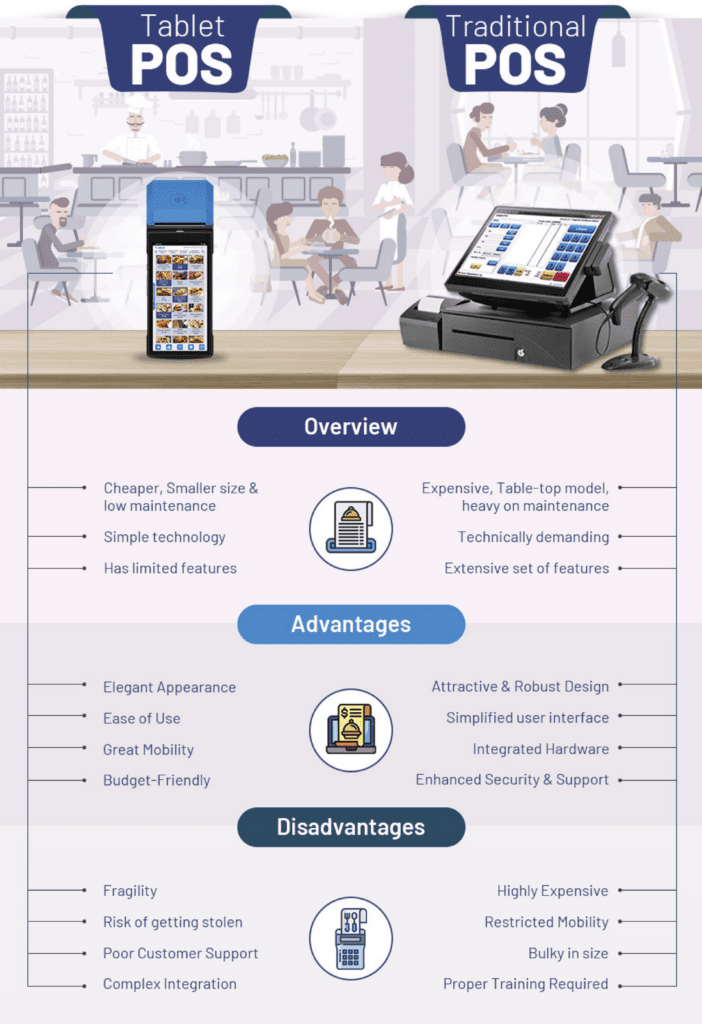
Tablet vs. Traditional POS Systems
During your childhood, toy cars brought joy to your heart, but it was only your actual car that truly made driving a delightful experience.
Financially speaking, touch-screen tablet POS systems are generally cheaper alternatives to traditional point-of-sale systems. With its small size, it is easier to set up and maintain a Tablet POS because It has fewer moving parts as against the traditional POS system. For these reasons, many small businesses choose a touch-screen tablet over the more expensive and technically demanding traditional system.
However, it is important to note that while tablets might be cheaper to purchase upfront, they don’t offer the same features as a more expensive traditional system. Let’s say you plan to keep your business open for long hours. Using a traditional system will last longer, so for this situation it makes sense. Its robust, expansive, and scalable nature will support more features in the coming years.
As for all-in-one POS system, you can expect additional devices like a barcode scanner, credit card reader, receipt printer, and more. There are two types of terminal POS systems: On-premise and Cloud-based. The difference between these two systems lies in the the method of accessing the software. The on-premise POS system counts on the locally installed server to access its POS software, while the cloud-based system requires the internet to access its POS software preserved in the cloud (remote server). A Cloud-based system has several advantages over an On-premise POS system.
If your business is just starting out or if financial constraints are limiting your options, consider using a tablet-based point-of-sale system. It offers an affordable and convenient solution.
Contrary to this, if your business is well established and you want to scale it to become a better and bigger brand, make a Traditional POS System for Retailer your best friend.
Every coin has two sides, and so does every mountain, a valley.
Pros and Cons of a Tablet POS System
As mentioned earlier, Tablet POS has been the choice of many retailers. So let’s check the facts and discuss the Pros and Cons of a Tablet POS System.
Pros:
1. Sophisticated appearance
It’s sophisticated design is the first thing that catches your eye with the Tablet POS. As a shop owner, approaching clients with a tablet POS system conveys an implicit message to the guests: a high quality experience. Nowadays, young and old buyers have developed a liking for modern, beautiful, and handy gadgets. With the technologically advanced POS experience, it contributes to building the image that the retail on premise is of that same high quality.
2. Ease of Use
Smartphones and Tablets have been integral to our lives. Understanding how to operate a tablet comes as second nature. As an employees, using tablets makes everything just that much easier. With training for the relevant POS app, they will be good to go!
3. Mobility
Tablet POS are lightweight devices, and your staff can easily carry them. Who doesn’t love the freedom of movement while at work? There might be instances when your staff needs to carry card readers to the customer’s table to facilitate payments. Investing in a tablet POS system will serve the purpose well if you are a brick-and-mortar establishment, restaurant, or retail outlet. Thanks to mobility, POS systems are even increasing sales in fast food restaurants.
4. Fits your Budget
Tablets are generally affordably priced, helping you keep a check on your expenses. This is a significant reason why major shop owners switch to tablet POS. To further reduce your cost, you can use one of your tablets that has a decent configuration. All you pay is for the POS software subscription and other minor devices like the card reader and receipt printer.
Though things looks a little different from tablet to tablet. Talk to a friend or ask an industry expert to decide the best tablet for your needs. To make matters simple, check our Guide to help you Choose the Best POS Tablet for your Retail Business. You can further keep an eye on discount offers or weekend sales to grab the best deal on your tablet.
Cons:
1. Fragile
Traditional POS systems are robust and sustainable, while Tablet POS demands extra care. Tablets are prone to mishandling and physical damage. You can only expect your employees to care for your tablet POS if you do.
Installing a screen guard or toughened glass on your tablet’s display screen can help you somewhat mitigate the risk. Another step to consider taking is placing your tablet inside a tough protective back cover. Doing so will steal your device’s sleek look and charm at the same time it helps your staff comfortably handle the device.
On the opposing side a back cover adds to the tablet’s overall weight, making it bulky and difficult to carry for extended hours. You might invest in all protective accessories, but tablets perform optimally (usable lifespan) for 3 to 4 years only – Anything beyond that is a bonus.
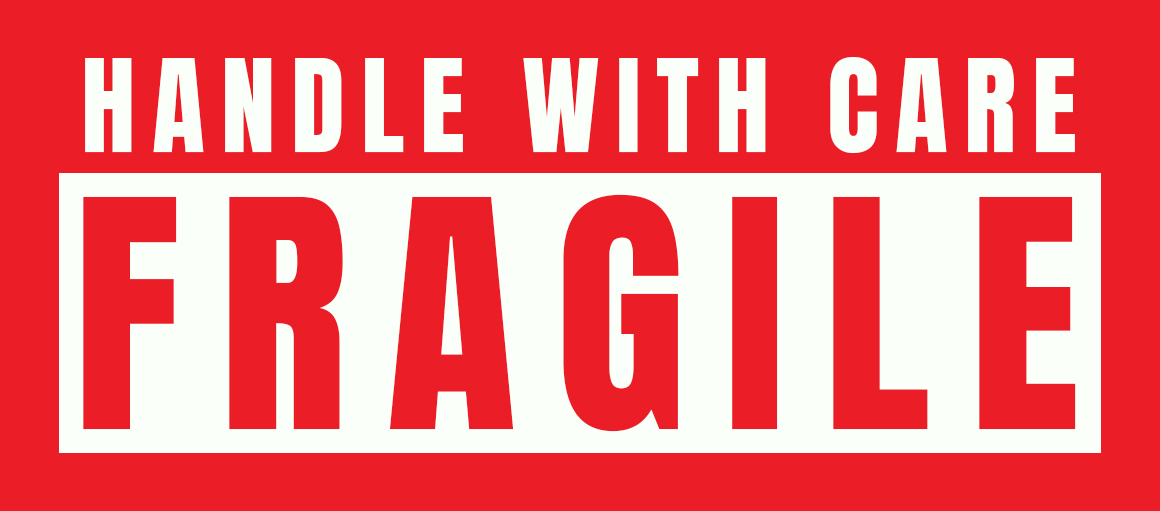
2. Risk of being stolen
A traditional POS might not offer mobility but safeguards against criminal mindsets. Imagine a traditional POS system fixed permanently on your billing or checkout counter. Your customers (and employees) will respect its presence.
Now think about your beautiful, sleek tablet POS lying unattended in one of the corners of your store. Thieves can play their game when your staff is not vigilant.
3. Limited Customer Support
When you subscribe to (or purchase) POS Software, you can expect the vendor to support you. But this support will be limited to the POS software only.
Any issues arising from tablet OS or hardware malfunction would require you to seek support from the tablet manufacturer or his service partner.
Seeking support across geographical boundaries is another consideration. If you are fortunate enough, you might come across an OEM who manufacturer the tablet and its POS software.
If that is the scenario with you, there is nothing to worry as you will receive a complete warranty and support thereafter.
4. Awkward use
During the whole day, your tablet keeps shifting places/hands and gathers dust and bacteria, generating a dense and unhygienic environment around itself. Your employees pick it to book and complete their sales orders while your customers receive it to make their payments. Your staff must sanitize it after every use or at regular intervals.
5. Complex integration
Did you say that tablets are plug-n-play devices? They are a tough nut to crack.
When you consider using your tablet with POS-related equipment like a barcode scanner, digital scale, credit/debit card reader, and receipt printer, performing a complete and flawless integration can be a pain in the neck.
These days, couple of Tablet OEMs have started manufacturing peripherals that make the tablet setup complete. These peripherals are manufactured keeping in view the technology used in the Tablet POS systems.
There are a handful of such suppliers who can properly integrate all the necessary devices to ensure a seamless integration at your end.

Pros and Cons of a Traditional POS System
‘Traditional’ doesn’t mean this type of POS is some old-fashioned, outdated POS system. On the contrary, the word traditional implies that it has all the foundational and advanced features necessary for a successful POS system. There are many models available in the market to choose from. We will discuss the advantages and disadvantages of a standard Cloud-Based all-in-one POS System. For any product, we generally begin with the pros and conclude with its cons.
Pros
1. Elegant appearance
Sleek and elegant looks are by no means proprietary to a tablet POS. Even the modern-day traditional or terminal POS offers an attractive look and robust design. You can opt for a glossy or matt-finished touch screen that is superior in quality to tablets.
2. Ease of Use
The traditional POS offers a simple user interface, just as a tablet POS. Vendors nowadays offer a simple yet attractive software design/interface that saves time and doesn’t overload the system (hardware). Proper training and your staff will be pro’s at operating the POS software.
The process flow is also broken down into simple tasks to avoid errors arising from complex workflow designs.
3. Integrated Hardware
The phrase traditional all-in-one POS system means that this kind of POS system has every feature well-embedded within its software and supports all the peripheral hardware. A traditional POS system is designed to specifically to support and boost flawless hardware communication, streamlining the overall sales procedure at the counter and helping make sales easier. This advanced feature is something tablets can’t compete with.
4. Customer support
As previously mentioned a Traditional POS System, comes with a complete package of hardware and software tuned to work together seamlessly. The company that sells you this package will offer you a warranty for the complete package, i.e., every usable device that is a part of this package.
In the same way, the company provides you with support for the complete package. Isn’t it amazing that you don’t need to rush to different vendors for individual components? All these hardware equipment are tested individually and when working with the rest of the setup.
Hence, you always save time, and energy when you purchase a terminal POS system. Peace of mind is guaranteed.
5. Enhanced security
Fear of damage or theft is not a worry with traditional POS. Stealing a terminal POS system is difficult; employees must log in with their official username to use a traditional POS. This type of POS comes with dual display screens.
The second screen at the back allows your customers to view their purchase information. The second screen is only a view-only screen. It doesn’t support any touchscreen inputs. Hence your frontside touch screen remains safe. It supports a physical keyboard, mouse, and barcode scanner to ensure accurate inputs.
Cons
1. Upfront cost
Focusing on costs, a tablet POS and a traditional POS system aren’t even comparable. As mentioned above, a Traditional POS is a complete package of all hardware equipment with its well-integrated POS software. Putting all these together will enhance your overall investment making it an expensive affair.
Additionally, you will have to pay for transportation or delivery. The complete setup will take up dedicated space when you install a traditional POS system on your checkout counter (with other peripheral devices). For commercial space, every inch counts. Only some retailers consider this aspect, but it is equally important.
2. Restricted mobility
A terminal POS is a bulky device fixed at one location. If your retail business participates in fairs, trade shows, or occasional events, you must have a mobile or tablet POS to complete your sales transactions at the venue. You can invest in a tablet and buy a POS software subscription for such temporary locations.
Opting for cloud-based software that syncs with your shop’s terminal POS through the cloud is preferable. You can access your store’s data on your tablet through this cloud technology. This will help you keep an eye on the sales transactions at your retail outlet while taking care of new sales at a fair or trade show.
Sometimes using both Tablet POS and Traditional POS in sync nullify each other’s drawbacks, finally offering a bouquet of benefits that no individual system can give you.
Why Do Experts Recommend Buying A POS System In Sync With Your Purpose?
We have discussed the advantages and disadvantages of both POS types in detail. Upon closer examination, it becomes evident that the Traditional POS system possesses significantly fewer drawbacks in comparison to the tablet POS system. A Traditional POS is robust and expansive, making it sustainable and future-ready. With time you can always upgrade the hardware and the software to avail the latest features and facilities.
In the case of a tablet POS, the first challenge you would face is finding compatible peripheral devices (like a card reader, receipt printer, etc.) that performs seamlessly with your tablet POS. If reconsidering, you can approach a vendor who provides you a Tablet, integrated POS software, and all the necessary devices. In this case you can overcome this hurdle and also take hardware-level support for your tablet if needed. Priority is a company that can support you in your journey to grab a complete Tablet POS solution.
Tablets were never meant to expand like the Traditional POS. Considering the maximum usable lifespan of tablets is 3 to 4 years, you would have recovered your investment by this time. When you scrap the old tablet POS and opt for a fresh new tablet POS (from the same vendor), you can expect to receive the latest in technology and style. Not to forget that your migration would be pretty smooth.
As a best business practice, always use the product in sync with its purpose. Any deviation might land you in hot waters. Choosing between a Tablet POS system and a Traditional POS system might depend on an individual’s preference. Still, the main intention of this blog is to give you a clear and concise picture helping you make an informed decision.





